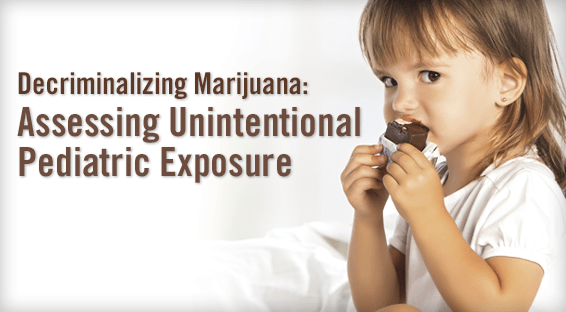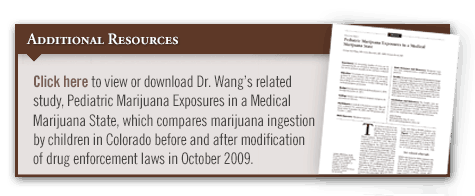Throughout the United States, the legalization of marijuana is being debated by the public and in government forums. Although still criminalized at the federal level, decriminalization at the state level has received national attention because several states have enacted marijuana legislation for medical and recreational purposes. As of 2013, 18 states and the District of Columbia have passed legislation allowing for the use of medical marijuana, which includes many edible products, and sales are projected to more than double by 2015. More recently, Washington and Colorado have decriminalized small amounts of recreational marijuana.
In 2004, the American Academy of Pediatrics released a policy statement that expressed concern about potential abuse of marijuana among adolescents in the context of decriminalization. There has been some evidence of medical marijuana being diverted to adolescents and recent reports of marijuana exposure to younger children. Studies suggest that there has been a slight increase in symptomatic, unintentional marijuana exposures since 2009. “Most of these exposures were from medical marijuana, which was often packaged as food products,” explains George S. Wang, MD, FAAP. “As such, it’s important to examine the effect that decriminalizing marijuana has had on children.”
Assessing Trends in Marijuana Exposure
In a study from Annals of Emergency Medicine, Dr. Wang and colleagues compared trends in unintentional marijuana exposures to children up to the age of 9 as measured by call volumes that were reported to U.S. poison centers. The authors hypothesized that decriminalized and transitional states would experience greater increases in call volume and have more symptomatic exposures and healthcare admissions than non-legal states.
“States that decriminalized marijuana had significant increases in the number of children requiring medical interventions, but the overall number of unintentional marijuana exposures among children was low,” says Dr. Wang. More patients were evaluated in a healthcare facility in decriminalized states compared with non-legal states. The symptoms that pediatric patients experienced varied, but neurologic effects were most common. The majority of patients had clinical effects lasting fewer than 24 hours (Table 1), and ingestion was the most common route of exposure.
The study also found that patients evaluated in decriminalized states were more likely to have major or moderate effects and be admitted to critical care units when compared with those in non-legal states (Table 2). Most patients treated in a healthcare facility were eventually discharged from the ED, and many who were exposed to marijuana did not have documentation of receiving therapeutic interventions. Overall, the most common treatment was IV fluids. The study authors found that aggressive interventions were rare, and no deaths were reported in the analysis.
Prevention Efforts On Edible Marijuana Products
As more states pass legislation to decriminalize medical and recreational marijuana, it is possible that the rate of marijuana exposures in young children will continue to increase. “We believe that high-dose edible products like candies, cookies, and chocolates may have played an important role in our study findings,” says Dr. Wang. “Oftentimes, children can’t distinguish between products that contain marijuana and those that don’t. These edible products may be attractive to children and tend to contain higher concentrations of tetrahydrocannabinol, the active ingredient in marijuana, and may lead to more severe symptoms.”
According to Dr. Wang, ongoing surveillance is crucial in assessing the effect of the marijuana industry on children and evaluating preventive efforts as it continues to expand. “Emergency physicians, toxicologists, and others should advocate for the safety of children to lawmakers as the marijuana industry grows across the U.S.,” he says. “As more states decriminalize the drug, lawmakers should be encouraged to create protective requirements to reduce the likelihood of ingestion by young children.” He says that child-resistant packaging, warning labels, and public education about these products when drafting marijuana legislation may prove to be valuable interventions.
The symptoms of children exposed to marijuana may be more severe than what has been previously suspected, and Dr. Wang says that more research is needed to get a better grasp on the problem. “The hope is that future research will monitor states that have decriminalized marijuana for unintended consequences,” he says. “We also need to learn more about specific symptoms that children develop so we can better recognize exposures.”




 TimH
TimH